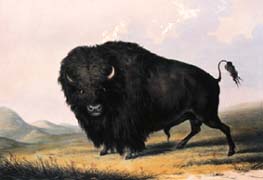
Illinois was home to many species of animals. More than twenty-nine thousand animal species (including insects) are native to the state, although some of these are currently listed as endangered, threatened, extirpated, or extinct. Bison (Bison bison) were the largest animals in the upland prairies. They captured the attention of Jacques Marquette and other French observers, who referred to them as "wild cattle," "pisikious," or "buffalo." Marquette reported seeing a herd of 400 bison in 1673, and others saw herds numbering in the thousands. However, bison populations dropped suddenly because of great hunting pressure, and in Illinois none remained in the wild by about 1830. Most other large mammals were also extirpated from the state, including the gray wolf (Canis lupus), black bear (Ursus americanus), mountain lion (Felis concolor), American elk (Cervus elaphus), and, until it was reintroduced, the white-tailed deer (Odocoileus virginianus).
We killed a little parroquet, one half of whose head was red, The other half and The Neck yellow, and The whole body green. (Jacques Marquette, 1674)![]()
Some animals observed historically in Illinois have become extinct, including four species of birds and six species of freshwater mussels. Two of the birds--the Carolina parakeet (Conuropsis carolinensis) and the passenger pigeon (Ectopistes migratorius)-- were formerly common to abundant. The Carolina parakeet occurred in flocks of up to 60 birds, while flocks of passenger pigeons numbered in the thousands. Both were hunted to extinction, the parakeet because it was considered an orchard pest and the passenger pigeon as a game bird. The ivory-billed woodpecker (Campephilus principalis) and the Eskimo curlew (Numenius borealis) are also extirpated or have become extinct. The six extinct mussel species are members of the genus Epioblasma. They lived historically in the Ohio and Wabash rivers, where mussels were once so abundant that in some places they paved the stream bed. Mussel extinction was caused by a host of factors, including pollution, siltation, over-harvesting, and loss of habitat.![]()
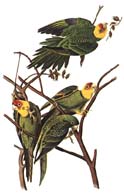 1. |
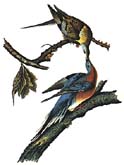 2. |
|
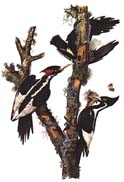 3. |
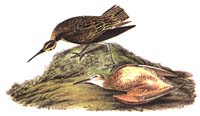 4. |
1. Carolina parakeet (Conuropsis carolinensis)
(watercolor by J.J. Audubon, 1851-54)
2. Passenger pigeon (Ectopistes migratorius)
(watercolor by J.J. Audubon)
3. Ivory-billed woodpecker (Campephilus principalis)
(watercolor by J.J. Audubon)
4. Eskimo curlew (Numenius borealis)
(watercolor by J.J. Audubon)
|
|
Copyright © 2000 Illinois State Museum
